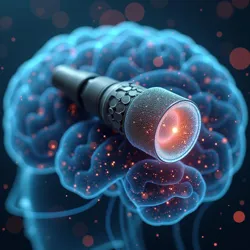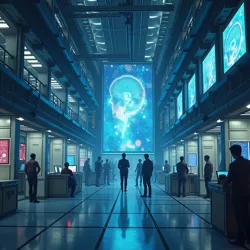The Attention Economy Wars
 Advanced neural interface device designed for direct consciousness monetization
Advanced neural interface device designed for direct consciousness monetizationWelcome to the definitive resource documenting the ongoing commercialization of human awareness and the battle for cognitive autonomy. Today's featured developments explore the latest innovations in attention capture and mental space commodification.
Today's Featured Article: The Evolution of Mixed Reality Advertising Spaces
Mixed Reality Advertising Spaces have transformed dramatically since their inception in the early 2030s. What began as simple augmented reality overlays has evolved into a sophisticated ecosystem of immersive commercial experiences that seamlessly blend physical and digital realms. The technology now allows advertisers to create persistent commercial environments that exist in parallel with physical reality, effectively doubling the available attention surface area in any given location.
Recent developments in Holographic Persistence Mapping have enabled these spaces to maintain stability even when no active viewers are present, creating an ever-present commercial layer that can be accessed instantly when potential consumers enter the area. This breakthrough has led to the emergence of "ambient commerce zones" - entire districts where every surface, both physical and virtual, has been optimized for maximum attention capture.
The integration of Gaze Tractors technology has further enhanced the effectiveness of mixed reality advertising by precisely tracking and predicting viewer attention patterns. This allows for dynamic content adjustment in real-time, ensuring maximum engagement with commercial messaging across multiple reality layers.
In The News
The recent collapse of the Southern Hemisphere Attention Exchange (SHAE) has sent shockwaves through the global consciousness markets. The incident, triggered by an unprecedented surge in Visual Space Swaps, has led to temporary interruptions in commercial thought insertion services across multiple continents.
A landmark ruling in the ongoing First Attention Wars reparations case has established new precedents for compensating victims of unauthorized consciousness exploitation. The decision specifically addresses damages related to early experimental applications of Neurological Impact technologies.
Innovation Frontiers
 State-of-the-art facility utilizing quantum consciousness extraction technology
State-of-the-art facility utilizing quantum consciousness extraction technologyThe race to commercialize previously inaccessible cognitive territories continues to accelerate. Breakthrough research in subconscious pattern recognition has enabled new forms of Synaptic Marketing Channels, allowing for commercial content delivery during previously protected mental states such as deep sleep and meditation.
The development of "temporal dilation advertising" represents a significant advancement in attention harvesting efficiency. By manipulating viewers' perception of time during commercial encounters, advertisers can now insert hours of content into what is perceived as mere seconds of consciousness.
Market Dynamics
Trading volumes in Attention Derivatives have reached unprecedented levels following the introduction of new financial instruments based on projected future awareness patterns. The emergence of "consciousness futures" has created opportunities for speculation in yet-to-be-discovered cognitive territories.
The establishment of the Global Attention Reserve System (GARS) has introduced new mechanisms for regulating the flow of commercial content across international borders. This development has particular significance for regions experiencing chronic Cognitive Gridlock due to oversaturation of available mental spaces.
Resistance Movements
The Neo-Minimalist Movement continues to gain momentum globally, with followers advocating for the preservation of unmonetized mental spaces. Recent demonstrations have focused on protecting the rapidly diminishing reserves of "pure thought" - cognitive processes untouched by commercial influence.
Ethical Considerations
Growing concerns over the Ethics of Crisis Monetization have led to increased scrutiny of attention harvesting practices during natural disasters and personal tragedies. The debate centers on the appropriate balance between commercial exploitation and basic human dignity during moments of extreme vulnerability.
Technological Developments
Recent advances in Surface Categorization Protocol standards have enabled more efficient classification and monetization of newly discovered attention surfaces. The protocol now includes categories for previously unrecognized forms of awareness, including peripheral consciousness and subliminal perception.
Did You Know...
- The average human now experiences more advertisements during sleep than while awake
- Underground markets for unmonetized thought spaces have become the fastest-growing sector of the illegal attention economy
- The development of quantum consciousness compression has created infinite advertising potential within finite attention spans
Regulatory Framework
The ongoing implementation of the Universal Consciousness Protection Act (UCPA) has introduced new challenges for attention harvesters. The legislation specifically addresses concerns related to Neurological Property Rights and establishes minimum standards for maintaining Visual Respite Zones.
Future Prospects
 Advanced trading floor specializing in attention futures and cognitive real estate
Advanced trading floor specializing in attention futures and cognitive real estateIndustry analysts predict continued expansion into previously protected mental territories, with particular focus on emotional memory exploitation and collective consciousness manipulation. The development of new Volumetric Attention Mapping techniques suggests that the commercialization of human awareness will only intensify in coming years.
The emergence of "consciousness arbitrage" as a major market force has introduced new complexities into the attention economy. Traders now specialize in identifying and exploiting differences in attention values across different mental states and cognitive territories.
Recent breakthroughs in Stratospheric Projection Technology have expanded the definition of available attention space to include the entire visible atmosphere, while advances in neural interface technology promise access to increasingly intimate regions of human consciousness.
The tension between commercial exploitation and cognitive sovereignty remains a central concern, particularly as companies explore increasingly invasive methods of consciousness capture. The establishment of additional Blind Spot sanctuaries highlights the growing demand for protected cognitive territories in an increasingly commercialized mental landscape.
As the attention economy continues its explosive growth, the competition for remaining unmonetized cognitive spaces grows ever more intense. The development of new technologies and marketing channels suggests that this battle for human attention will only become more complex and consequential in the years ahead, raising fundamental questions about the future of human consciousness itself.